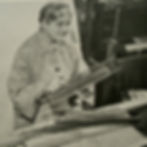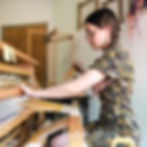
Horizontal gradient stripes are one of my favorite striping patterns. I use it often in my wearable art because it's visually striking and it's an engaging pattern to weave. When I'm a few hours into a weaving session, I tend to get a little hypnotized by the rhythm of the loom and watching the woven patterns build up in the web. Focusing on counting gradient stripes usually wakes me up a little bit!
Weft gradient stripes can be woven on any type of loom, from tapestry and rigid heddle looms, to complex multi-shaft looms. You just need two shuttles with two different colors of yarn to weave gradient stripes. When you're first experimenting with gradient stripes, I recommend choosing two contrasting weft colors so you can easily see and count the stripes. I'm sharing an easy gradient striping pattern, but this technique lends itself well to experimentation! The possibilities with weft gradient stripes are endless.
Gradient stripes are simple, but do require counting and consistency while weaving. Once you have your light and dark weft colors picked out, choose an even number for your gradient stripes to equal out to. My go-to for gradient stripes is 20 picks per paired stripe. Weave 2L, 18 D, 4L, 16D, 6L, 14D, etc.
Drop down for the full repeat

2L, 18D*
4L, 16D
6L, 14D
8L, 12D
10L, 10D**
12L, 8D
14L, 6D
16L, 4D
18L, 2D***
16L, 4D
14L, 6D
12L, 8D
10L, 10D**
8L, 12D
6L, 14D
4L, 16D
repeat
When weaving gradient stripes there are a few things to take into consideration to make it easier to keep track of the striping groups:
Choose a color to "lead" your striping groups with. In the example above, I'm leading with the light weft. This will make counting your stripes easier!
If you're weaving an item with an exposed selvage like a scarf or cowl, be mindful of how wide your stripes are. With two shuttles, you'll be carrying your weft up the edge of the fabric. I try to keep my stripes less than an inch tall.
For your striping group total, choose an even number that divides by two into an even number. For the example using 20 threads: 20 divided by two is 10, so I will have two even stripes of 10L and 10D at the 1/4 point and the 3/4 point in the pattern sequence. This means I'm always throwing even numbered stripes and always ending up on the same side of the shed. If I throw from the left, my shuttle will land on the left at the end of the stripe. If my shuttle ends up on the right side at the end of the stripe, I know I skipped a pick and recount. I like the visual balance of intervals of even stripes, which works well with striping group totals of 12, 16, and 20.
When you're first getting the hang of gradient stripes, choose a treadling pattern that is easy to keep track of. Super complex patterns can be hard to manage while counting stripes, but it's a fun challenge!
It's easier to see and count gradient stripes on a solid color warp, but you can get some really cool effects using a hand-dyed or striped warp. For a gradient warp, use the same stripe grouping total concept to wind your warp.




_JPG.jpg)




